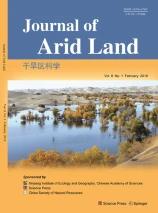Spatiotemporal variations of tenebrionid beetles (Coleoptera: Tenebrionidae) in the Gobi desert, Northwest China
2025-01-01 null null 17(卷), null(期), (null页)
Tenebrionid beetles represent a crucial arthropod taxon in the Gobi desert ecosystems owing to their species richness and high biomass, both of which are essential for maintaining ecosystem health and stability. However, the spatiotemporal variations of tenebrionid beetle assemblages in the Gobi desert remain poorly understood. In this study, the monthly dynamics of tenebrionid beetles in the central part of the Hexi Corridor, Northwest China, a representative area of the Gobi desert ecosystems, were monitored using pitfall trapping during 2015-2020. The following results were showed: (1) monthly activity of tenebrionid beetles was observed from March to October, with monthly activity peaking in spring and summer, and monthly activity periods and peak of tenebrionid beetle species exhibited interspecific differences that varied from year to year; (2) spatial distribution of tenebrionid beetle community was influenced by structural factors. Specifically, at a spatial scale of 24.00 m, tenebrionid beetle community was strongly and positively correlated with the dominant species, with distinct spatial distribution patterns observed for Blaps gobiensis and Microdera kraatzi alashanica; (3) abundance of tenebrionid beetles was positively correlated with monthly mean precipitation and monthly mean temperature, whereas monthly abundance of B. gobiensis and M. kraatzi alashanica was positively correlated with monthly mean precipitation; and (4) the cover of Reaumuria soongarica (Pall.) Maxim. and Nitraria sphaerocarpa Maxim. had a positive influence on the number of tenebrionid beetles captured. In conclusion, monthly variation in precipitation significantly influences the community dynamic of tenebrionid beetles, with precipitation and shrub cover jointly determining the spatial distribution pattern of these beetles in the Gobi desert ecosystems.
相关推荐
- Application of water-stable isotopes in quantitative identification of groundwater-dependent vegetations: A soil sampling strategy [2025-01-01]
- Responses of Soil Water Potential and Plant Physiological Status to Pulsed Rainfall Events in Arid Northwestern China: Implications for Disclosing the Water-Use Strategies of Desert Plants [2025-01-01]
- Soil macrofauna trophic structure and its relationship with soil factors in oases of contrasting cultivation ages [2025-01-01]
- Long-term effects of conventional cultivation on soil cation exchange capacity and base saturation in an arid desert region [2025-01-01]
- Spatial and temporal distribution patterns of ants (Hymenoptera: Formicidae) in Gobi Desert ecosystems, Northwest China [2025-01-01]



